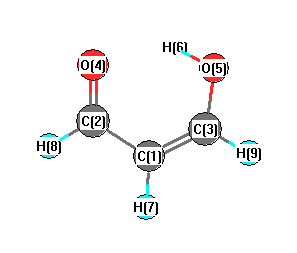Vibrational Frequencies calculated at CCSD(T)/6-31G*
| Mode Number |
Symmetry |
Frequency
(cm-1) |
Scaled Frequency
(cm-1) |
IR Intensities
(km mol-1) |
Raman Act
(Å4/u) |
Dep P |
Dep U |
|---|
| 1 |
A' |
3367 |
3239 |
|
|
|
|
| 2 |
A' |
3231 |
3108 |
|
|
|
|
| 3 |
A' |
3198 |
3076 |
|
|
|
|
| 4 |
A' |
3008 |
2894 |
|
|
|
|
| 5 |
A' |
1731 |
1665 |
|
|
|
|
| 6 |
A' |
1668 |
1605 |
|
|
|
|
| 7 |
A' |
1491 |
1435 |
|
|
|
|
| 8 |
A' |
1446 |
1392 |
|
|
|
|
| 9 |
A' |
1427 |
1372 |
|
|
|
|
| 10 |
A' |
1297 |
1248 |
|
|
|
|
| 11 |
A' |
1124 |
1081 |
|
|
|
|
| 12 |
A' |
996 |
958 |
|
|
|
|
| 13 |
A' |
892 |
858 |
|
|
|
|
| 14 |
A' |
504 |
484 |
|
|
|
|
| 15 |
A' |
292 |
281 |
|
|
|
|
| 16 |
A" |
1027 |
988 |
|
|
|
|
| 17 |
A" |
959 |
923 |
|
|
|
|
| 18 |
A" |
841 |
809 |
|
|
|
|
| 19 |
A" |
756 |
727 |
|
|
|
|
| 20 |
A" |
368 |
354 |
|
|
|
|
| 21 |
A" |
260 |
250 |
|
|
|
|
Unscaled Zero Point Vibrational Energy (zpe) 14939.6 cm
-1
Scaled (by 0.9621) Zero Point Vibrational Energy (zpe) 14373.4 cm
-1
See section
III.C.1 List or set vibrational scaling factors
to change the scale factors used here.
See section
III.C.2
Calculate a vibrational scaling factor for a given set of molecules
to determine the least squares best scaling factor.
